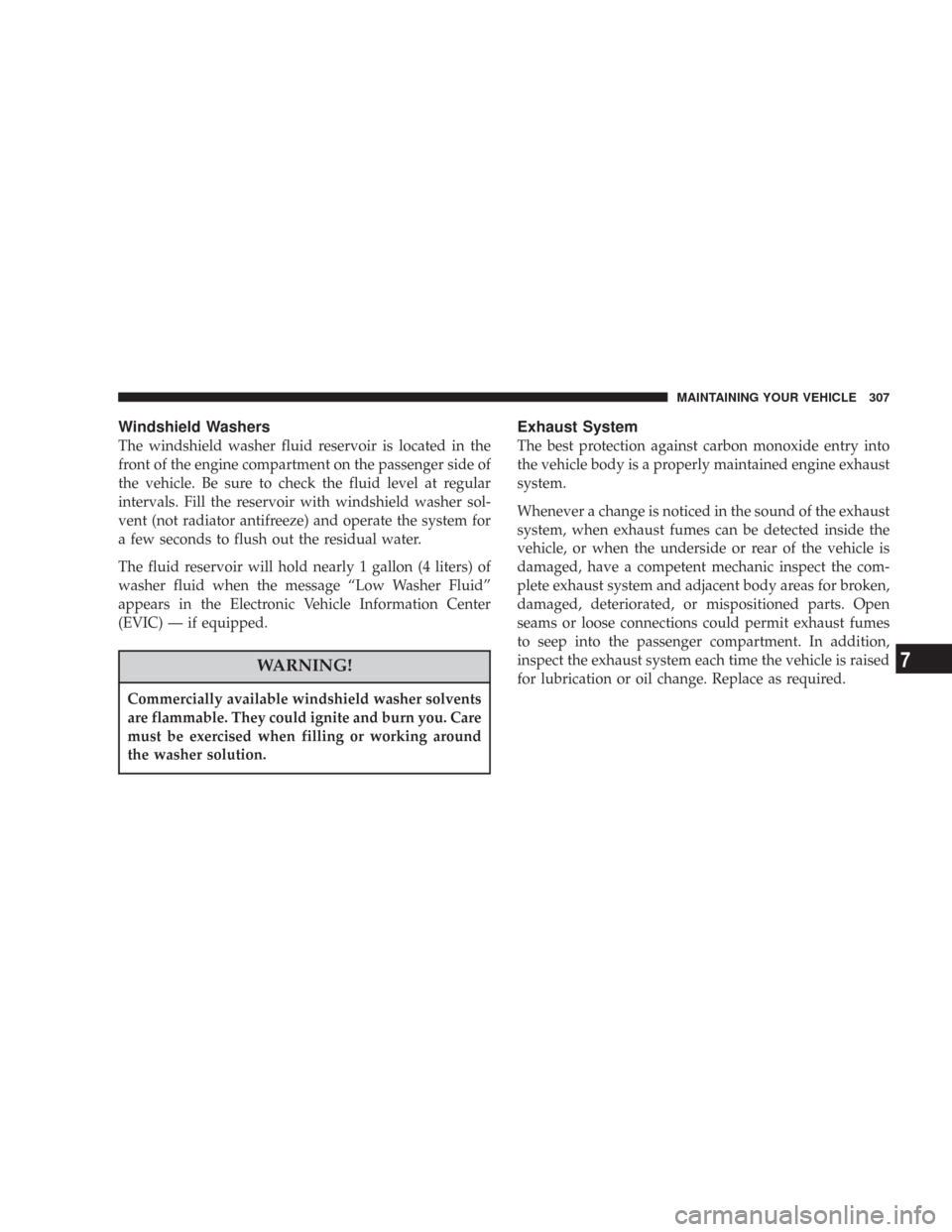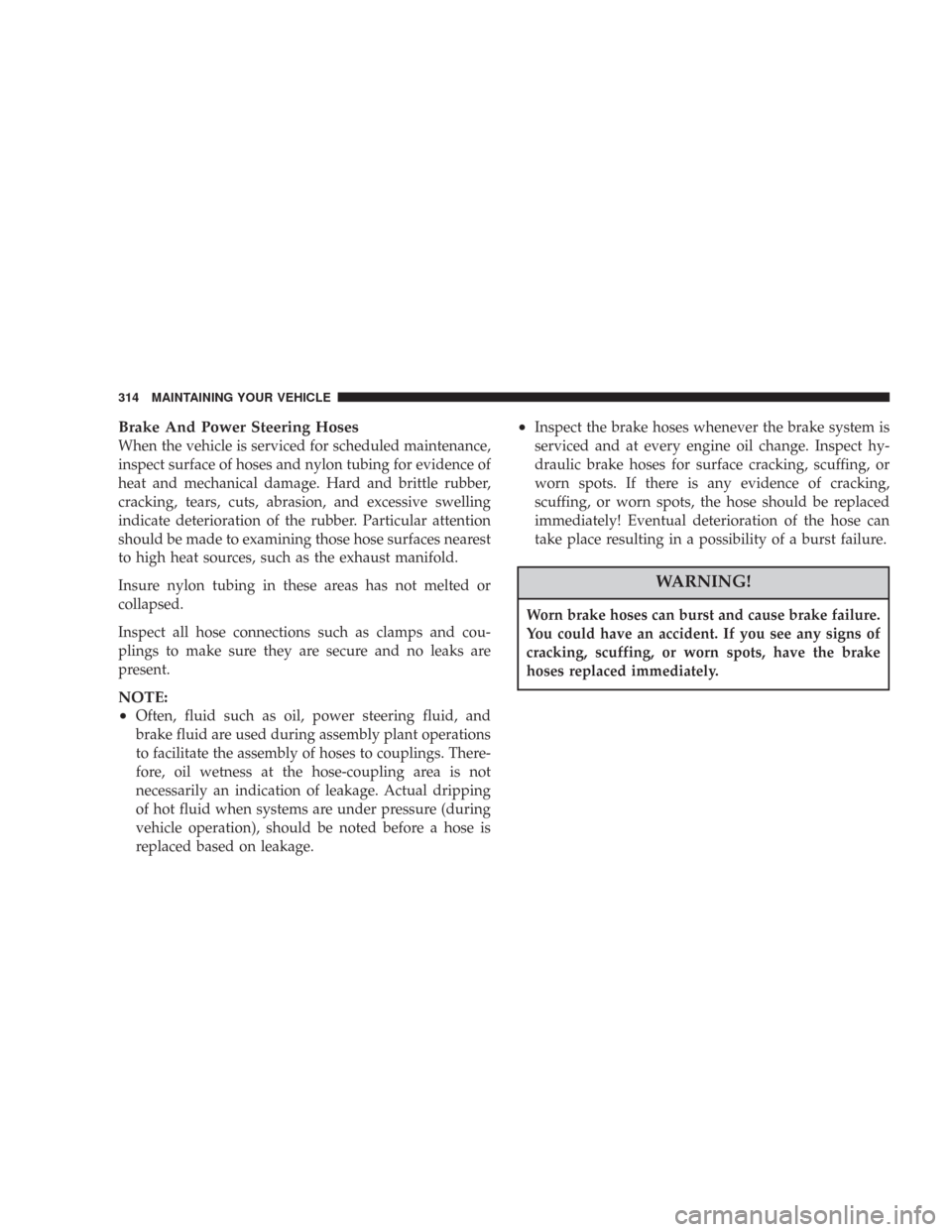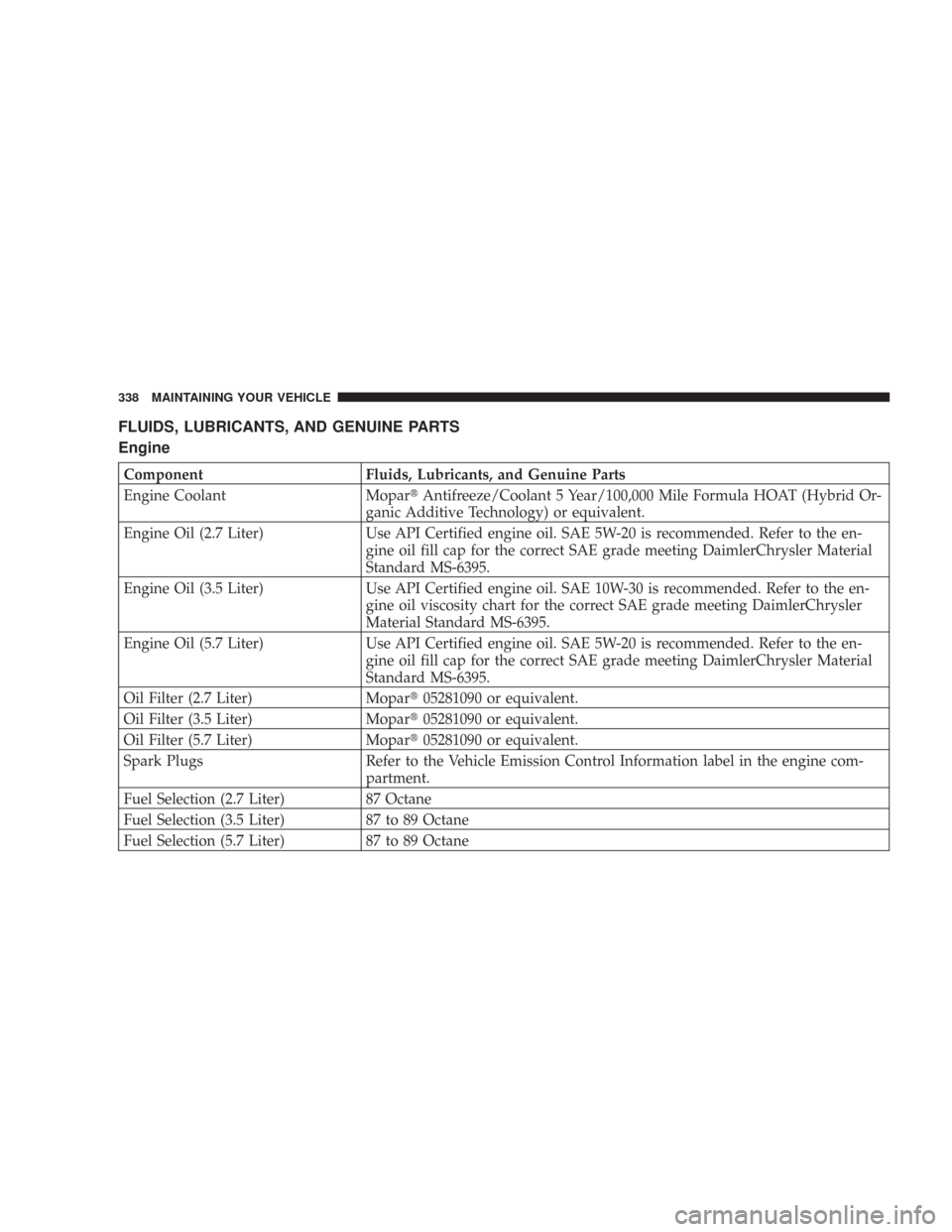Page 307 of 384

Windshield Washers
The windshield washer fluid reservoir is located in the
front of the engine compartment on the passenger side of
the vehicle. Be sure to check the fluid level at regular
intervals. Fill the reservoir with windshield washer sol-
vent (not radiator antifreeze) and operate the system for
a few seconds to flush out the residual water.
The fluid reservoir will hold nearly 1 gallon (4 liters) of
washer fluid when the message “Low Washer Fluid”
appears in the Electronic Vehicle Information Center
(EVIC) — if equipped.
WARNING!
Commercially available windshield washer solvents
are flammable. They could ignite and burn you. Care
must be exercised when filling or working around
the washer solution.
Exhaust System
The best protection against carbon monoxide entry into
the vehicle body is a properly maintained engine exhaust
system.
Whenever a change is noticed in the sound of the exhaust
system, when exhaust fumes can be detected inside the
vehicle, or when the underside or rear of the vehicle is
damaged, have a competent mechanic inspect the com-
plete exhaust system and adjacent body areas for broken,
damaged, deteriorated, or mispositioned parts. Open
seams or loose connections could permit exhaust fumes
to seep into the passenger compartment. In addition,
inspect the exhaust system each time the vehicle is raised
for lubrication or oil change. Replace as required.
MAINTAINING YOUR VEHICLE 307
7
Page 314 of 384

Brake And Power Steering Hoses
When the vehicle is serviced for scheduled maintenance,
inspect surface of hoses and nylon tubing for evidence of
heat and mechanical damage. Hard and brittle rubber,
cracking, tears, cuts, abrasion, and excessive swelling
indicate deterioration of the rubber. Particular attention
should be made to examining those hose surfaces nearest
to high heat sources, such as the exhaust manifold.
Insure nylon tubing in these areas has not melted or
collapsed.
Inspect all hose connections such as clamps and cou-
plings to make sure they are secure and no leaks are
present.
NOTE:
•
Often, fluid such as oil, power steering fluid, and
brake fluid are used during assembly plant operations
to facilitate the assembly of hoses to couplings. There-
fore, oil wetness at the hose-coupling area is not
necessarily an indication of leakage. Actual dripping
of hot fluid when systems are under pressure (during
vehicle operation), should be noted before a hose is
replaced based on leakage.
•Inspect the brake hoses whenever the brake system is
serviced and at every engine oil change. Inspect hy-
draulic brake hoses for surface cracking, scuffing, or
worn spots. If there is any evidence of cracking,
scuffing, or worn spots, the hose should be replaced
immediately! Eventual deterioration of the hose can
take place resulting in a possibility of a burst failure.
WARNING!
Worn brake hoses can burst and cause brake failure.
You could have an accident. If you see any signs of
cracking, scuffing, or worn spots, have the brake
hoses replaced immediately.
314 MAINTAINING YOUR VEHICLE
Page 315 of 384

Master Cylinder — Brake Fluid Level Check
Check the fluid level in the master cylinder immediately
if the brake system warning light indicates system fail-
ure.
Check the fluid level in the master cylinder when per-
forming underhood services.
Clean the top of the master cylinder area before removing
the cap. Add fluid to bring the level up to the top of the
“FULL” mark on the side of the master cylinder reservoir.
Overfilling of fluid is not recommended because it may
cause leaking in the system.
Add enough fluid to bring the level up to the require-
ments described on the brake fluid reservoir. With disc
brakes, fluid level can be expected to fall as the brake
pads wear. However, low fluid level may be caused by a
leak and a checkup may be needed.
Use only manufacturer’s recommended brake fluid. Re-
fer to “Fluids, Lubricants, and Genuine Parts” in this
section for the correct fluid type.WARNING!
•Overfilling the brake fluid reservoir can result in
spilling brake fluid on hot engine parts and the
brake fluid catching fire.
•Use of a brake fluid that has a lower initial boiling
point than the recommended MOPAR�DOT 3
product or a brake fluid that is unidentified as to
FMVSS specification may result in sudden brake
failure during hard prolonged braking. You could
have an accident.
Use only brake fluid that has been in a tightly closed
container to avoid contamination from foreign matter or
moisture.
CAUTION!
Do not allow petroleum base fluid to contaminate
the brake fluid, all brake seal components could be
damaged causing partial or complete brake failure.
MAINTAINING YOUR VEHICLE 315
7
Page 337 of 384

FLUIDS AND CAPACITIES
U.S. Metric
Fuel (approximate)
2.7 Liter Engine 18 gallons 68 liters
3.5 Liter Engine 18 gallons 68 liters
5.7 Liter Engine 19 gallons 72 liters
Engine Oil-With Filter
2.7 Liter Engine (SAE 5W-20, API Certified) 6.0 qts. 5.7 liters
3.5 Liter Engine (SAE 10W-30, API Certified) 6.0 qts. 5.7 liters
5.7 Liter Engine (SAE 5W-20, API Certified) 7.0 qts. 6.6 liters
Cooling System *
2.7 Liter Engine (Mopar�Antifreeze/Coolant 5 Year/100,000 Mile For-
mula) or equivalent.9.9 qts 9.4 liters
3.5 Liter Engine without All Wheel Drive (Mopar�Antifreeze/Coolant
5 Year/100,000 Mile Formula) or equivalent.11.1 qts 10.5 liters
3.5 Liter Engine with All Wheel Drive (Mopar�Antifreeze/Coolant 5
Year/100,000 Mile Formula) or equivalent.11.4 qts 10.8 liters
5.7 Liter Engine without Severe Duty II Cooling System (Mopar�
Antifreeze/Coolant 5 Year/100,000 Mile Formula) or equivalent.14.7 qts 13.9 liters
5.7 Liter Engine with Severe Duty II Cooling System (Mopar�
Antifreeze/Coolant 5 Year/100,000 Mile Formula) or equivalent.15.1 qts 14.3 liters
* Includes heater and coolant recovery bottle filled to MAX level.
MAINTAINING YOUR VEHICLE 337
7
Page 338 of 384

FLUIDS, LUBRICANTS, AND GENUINE PARTS
Engine
Component Fluids, Lubricants, and Genuine Parts
Engine Coolant Mopar�Antifreeze/Coolant 5 Year/100,000 Mile Formula HOAT (Hybrid Or-
ganic Additive Technology) or equivalent.
Engine Oil (2.7 Liter) Use API Certified engine oil. SAE 5W-20 is recommended. Refer to the en-
gine oil fill cap for the correct SAE grade meeting DaimlerChrysler Material
Standard MS-6395.
Engine Oil (3.5 Liter) Use API Certified engine oil. SAE 10W-30 is recommended. Refer to the en-
gine oil viscosity chart for the correct SAE grade meeting DaimlerChrysler
Material Standard MS-6395.
Engine Oil (5.7 Liter) Use API Certified engine oil. SAE 5W-20 is recommended. Refer to the en-
gine oil fill cap for the correct SAE grade meeting DaimlerChrysler Material
Standard MS-6395.
Oil Filter (2.7 Liter) Mopar�05281090 or equivalent.
Oil Filter (3.5 Liter) Mopar�05281090 or equivalent.
Oil Filter (5.7 Liter) Mopar�05281090 or equivalent.
Spark Plugs Refer to the Vehicle Emission Control Information label in the engine com-
partment.
Fuel Selection (2.7 Liter) 87 Octane
Fuel Selection (3.5 Liter) 87 to 89 Octane
Fuel Selection (5.7 Liter) 87 to 89 Octane
338 MAINTAINING YOUR VEHICLE
Page 343 of 384

•Extensive engine idling.
•Driving in dusty conditions.
•Short trips of less than 10 miles (16 km).
•More than 50% of your driving is at sustained high
speeds during hot weather, above 90°F (32°C).
•Trailer towing.
•Taxi, police, or delivery service (commercial ser-
vice).
•Off-road or desert operation.
NOTE:IfANYof these apply to you, then change your
engine oil every 3,000 miles (5 000 km) or 3 months,
whichever comes first, and follow the maintenance rec-
ommendations in Schedule “B” in this section.
NOTE:IfANYof these apply to you, then flush and
replace the engine coolant every 102,000 miles (170 000
km) or 60 months, whichever comes first, and follow the
maintenance recommendations in Schedule “B” in this
section.
NOTE:Most vehicles are operated under the conditions
listed for Schedule�B.�
Second is Schedule“A.”It is for vehicles that are not
operated under any of the conditions listed under Sched-
ule�B.�
Use the schedule that best describes your driving condi-
tions. Where time and mileage are listed, follow the
interval that occurs first.
NOTE:Under no circumstances should oil change
intervals exceed 6,000 miles (10 000 km) or 6 months
whichever comes first.
CAUTION!
Failure to perform the required maintenance items
may result in damage to the vehicle.
MAINTENANCE SCHEDULES 343
8
M
A
I
N
T
E
N
A
N
C
E
S
C
H
E
D
U
L
E
S
Page 344 of 384

At Each Stop for Fuel
•
Check the engine oil level about 5 minutes after a fully
warmed engine is shut off. Checking the oil level while
the vehicle is on level ground will improve the accu-
racy of the oil level reading. Add oil only when the
level is at or below the ADD or MIN mark.
•Check the windshield washer solvent and add if
required.
Once a Month
•
Check tire pressure and look for unusual wear or
damage.
•Inspect the battery, and clean, and tighten the termi-
nals as required.
•Check the fluid levels of coolant reservoir and brake
master cylinder, and add as needed.
•Check all lights and all other electrical items for correct
operation.
•Check rubber seals on each side of the radiator for
proper fit.
At Each Oil Change
•
Change the engine oil filter.
•Inspect the exhaust system.
•Inspect the brake hoses.
•Inspect the CV joints and front and rear suspension
components.
•Check the coolant level, hoses, and clamps.
344 MAINTENANCE SCHEDULES
8
M
A
I
N
T
E
N
A
N
C
E
S
C
H
E
D
U
L
E
S
Page 345 of 384

SCHEDULE “B”
Follow Schedule “B” if you usually operate your vehicle
under one or more of the following conditions.
Change the automatic transmission fluid and filter every
60,000 miles (100 000 km) if the vehicle is usually
operated under one or more of the conditions marked
with an
.
•Day or night temperatures are below 32°F (0°C).
•Stop and go driving.
•Extensive engine idling.
•Driving in dusty conditions.
•Short trips of less than 10 miles (16 km).
•More than 50% of your driving is at sustained high
speeds during hot weather, above 90°F (32°C).
•Trailer towing.
•Taxi, police or delivery service (commercial ser-
vices).
•Off-road or desert operation.
NOTE:IfANYof these apply to you, then change your
engine oil every 3,000 miles (5 000 km) or 3 months,
whichever comes first, and follow the maintenance rec-
ommendations in Schedule “B” in this section.
NOTE:IfANYof these apply to you, then flush and
replace the engine coolant every 102,000 miles (170 000
km) or 60 months, whichever comes first, and follow the
maintenance recommendations in Schedule “B” in this
section.
SCHEDULE “B” 345
8
M
A
I
N
T
E
N
A
N
C
E
S
C
H
E
D
U
L
E
S